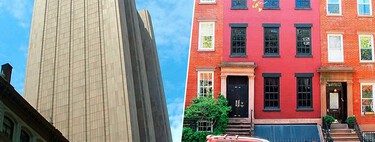If you have visited New York, there may be something that caught your attention more than the impressive skyscrapers. You’ve already seen these in dozens of movies, but one of the most emblematic cities in the world is also famous for a less glamorous phenomenon: the scaffolding that covers a large part of its buildings. It is enough to take a walk through almost any of the city’s streets, especially in the Manhattan area, to notice the hundreds of scaffolding and mesh that cover the facade of many buildings.
And it is something curious for two reasons: they are practically never removed and they are not only found in buildings under construction.
That they are removed is news. Wondering what happens in New York with the scaffolding is very normal. It’s not that there are many, it’s that there are too many. It is estimated that, placed in a row, the almost permanently installed scaffolding would be about 640 kilometers long and many have been standing for years. According to a map from the New York Administration, there are more than 9,000 scaffolding in the five boroughs. Basically, they have become part of the landscape of the city that never sleeps.
So much so that the city has begun to get its act together and, a few months ago, it was news the removal of a 100-meter-long scaffold that had remained in the same place for 15 years. The authorities confirmed that these are unsafe points for pedestrians because they can be sources of crime and, in recent weeks, 270 of these structures have been removed.
Local Law 11. But the big question may be why, what has led the city to erect so much scaffolding, turning some sidewalks into almost underground passageways. It turns out that it has first and last name: Facade Safety Law, or Local Law 11. Originally, it was Local Law 10, implemented in 1980 after the death of a young woman who was walking on the sidewalk and was hit by a dislodged piece of masonry. It must be taken into account that many New York facades are made of brick.
According to this regulation, all buildings with more than six floors had to undergo periodic façade inspections. This was mandatory to be completed every five years, with the condition of submitting a detailed report to the authorities. If any problem was found, the owner was required to make the necessary repairs immediately.
Money. Obviously, the problem It’s just that fixing the damage costs money. Keeping buildings in good condition is expensive and, taking into account that many buildings in the city are very old, restoration and maintenance work takes time. The cost is such that there are owners who decide to postpone the process, but leave the scaffolding installed because, in this way, debris is prevented from falling on passers-by. Furthermore, it is cheaper to leave the scaffolding set up there (some even with its own lighting so that there is light on the street) than to face the cost of the work on the building.
Security. To realize how ingrained scaffolding is in New York, we only have to notice that there is a name for it: scaffold blightwhich would become a “plague of scaffolding”. It is not something that anyone in the city likes, but it is a necessary element to avoid deaths like the one 40 years ago that motivated the creation of Local Law 10.
Alternatives to these structures that are ugly, harm to businesses and are crime hotspots? Networks, for example. Instead of installing full scaffolding, some companies are using protective netting or mesh that attaches directly to the building facade. These heavy-duty nets are capable of containing small and medium-sized debris, preventing it from falling onto the streets without the need for bulky structures and are more discreet than scaffolding. They also put on and take off more easily.

Issues. As we say, New York is determined to clean its streets of these metal and wooden masses (in some cases), but without giving up the safety that the scaffolding implies for pedestrians. The problem is that there are a host of factors that delay building maintenance work.
We have already mentioned that these are expensive and frequent repairs, but we must also take into account that the COVID-19 pandemic led to many projects being postponed, so there is a bottleneck in the system due to the accumulation of pending jobs. There is also a delay in building inspections, which means they must remain installed. And to that are added delays in construction permits and even possible labor shortages.
We must not forget that these maintenance tasks must also affect as little as possible the pace of a city as densely populated as this one, so cutting streets for long periods to rehabilitate a façade is another element that adds to the list of complications already mentioned. And, ultimately, although hundreds of scaffolding have been removed recently, thousands remain installed, which have already become iconic in the New York landscape.
Image | Hiku2
In Xataka | For decades we climbed this New York skyscraper without knowing that the screws that held it in place could not hold.











![[Img #74674]](https://thelatestnews.world/wp-content/uploads/2024/12/Santiago-Ramon-y-Cajal-The-promoter-of-modern-neuroscience-300x200.jpg)

Add Comment